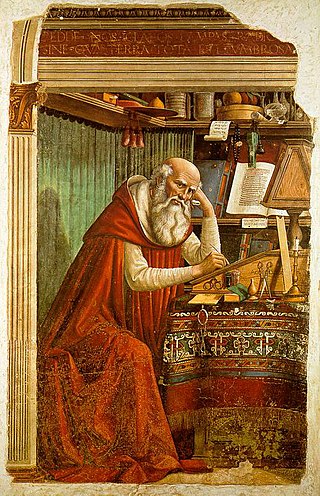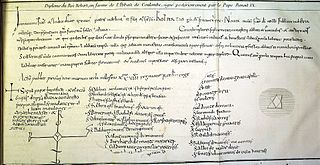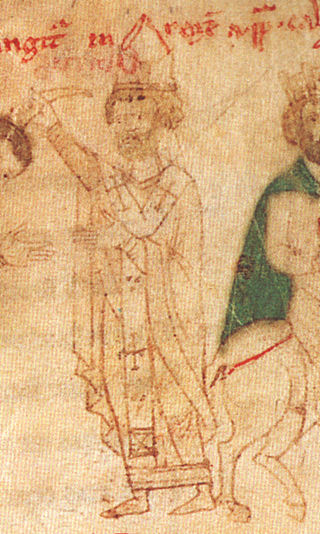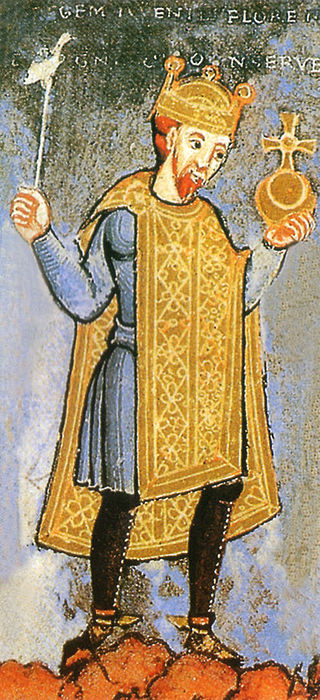Related Research Articles

The Concordat of Worms, also referred to as the Pactum Callixtinum or Pactum Calixtinum, was an agreement between the Catholic Church and the Holy Roman Empire which regulated the procedure for the appointment of bishops and abbots in the Empire. Signed on 23 September 1122 in the German city of Worms by Pope Callixtus II and Emperor Henry V, the agreement set an end to the Investiture Controversy, a conflict between state and church over the right to appoint religious office holders that had begun in the middle of the 11th century.

The Liber Pontificalis is a book of biographies of popes from Saint Peter until the 15th century. The original publication of the Liber Pontificalis stopped with Pope Adrian II (867–872) or Pope Stephen V (885–891), but it was later supplemented in a different style until Pope Eugene IV (1431–1447) and then Pope Pius II (1458–1464). Although quoted virtually uncritically from the 8th to 18th centuries, the Liber Pontificalis has undergone intense modern scholarly scrutiny. The work of the French priest Louis Duchesne, and of others has highlighted some of the underlying redactional motivations of different sections, though such interests are so disparate and varied as to render improbable one popularizer's claim that it is an "unofficial instrument of pontifical propaganda."

Pope Alexander II, born Anselm of Baggio, was the head of the Roman Catholic Church and ruler of the Papal States from 1061 to his death in 1073. Born in Milan, Anselm was deeply involved in the Pataria reform movement. Elected according to the terms of his predecessor's bull, In nomine Domini, Anselm's was the first election by the cardinals without the participation of the people and minor clergy of Rome. He also authorized the Norman Conquest of England in 1066.

Pope Benedict IX, born Theophylactus of Tusculum in Rome, was the bishop of Rome and ruler of the Papal States for three periods between October 1032 and July 1048. Aged about 20 when first elected, he is the youngest pope in history. He is the only person to have been Pope more than once and the only person ever accused of selling the papacy.

Pope Callixtus II or Callistus II, born Guy of Burgundy, was head of the Catholic Church and ruler of the Papal States from 1 February 1119 to his death in 1124. His pontificate was shaped by the Investiture Controversy, which he was able to settle through the Concordat of Worms in 1122.

Pope Gregory VII, born Hildebrand of Sovana, was head of the Catholic Church and ruler of the Papal States from 22 April 1073 to his death in 1085. He is venerated as a saint in the Catholic Church.

The Investiture Controversy or Investiture Contest was a conflict between the Church and the state in medieval Europe over the ability to choose and install bishops (investiture) and abbots of monasteries and the pope himself. A series of popes in the 11th and 12th centuries undercut the power of the Holy Roman Emperor and other European monarchies, and the controversy led to nearly 50 years of conflict.
The Gregorian Reforms were a series of reforms initiated by Pope Gregory VII and the circle he formed in the papal curia, c. 1050–80, which dealt with the moral integrity and independence of the clergy. The reforms are considered to be named after Pope Gregory VII (1073–85), though he personally denied it and claimed his reforms, like his regnal name, honoured Pope Gregory I.
Honorius II, born Pietro Cadalo, was an antipope from 1061 to 1072. He was born in the County of Verona, and became bishop of Parma in 1045. He died at Parma in 1072.
Bonizo of Sutri or Bonitho was a Bishop of Sutri and then of Piacenza in central Italy, in the last quarter of the 11th century. He was an adherent of Gregory VII and an advocate of the reforming principles of that pope. He wrote three works of polemical history, including Liber ad amicum, which detailed the struggles between civil and religious authorities. He was driven out of both of his dioceses, once by the emperor and once by opponents of Gregorian-style reform.

The pataria was an eleventh-century Catholic movement focused on the city of Milan in northern Italy, which aimed to reform the clergy and ecclesiastic government within the city and its ecclesiastical province, in support of papal sanctions against simony and clerical marriage. Those involved in the movement were called patarini, patarines or patarenes, a word perhaps chosen by their opponents, the etymology of which is uncertain. The movement, associated with urban unrest in the city of Milan, is generally considered to have begun in 1057 and ended in 1075.
Manegold of Lautenbach was a religious and polemical writer and Augustinian canon from Alsace, active mostly as a teacher in south-west Germany. William of Champeaux may have been one of his pupils, but this is disputed. He was one of the first magisters, recognised masters of theology.
Ad abolendam was a decretal and bull of Pope Lucius III, written at Verona and issued 4 November 1184. It was issued after the Council of Verona settled some jurisdictional differences between the Papacy and Frederick I, Holy Roman Emperor. The document prescribes measures to uproot heresy and sparked the efforts which culminated in the Albigensian Crusade and the Inquisitions. Its chief aim was the complete abolition of Christian heresy.
The Synod of Verona was held November 1184 under the auspices of Pope Lucius III and the Holy Roman Emperor Frederick I.

The history of the papacy from 1046 to 1216 was marked by conflict between popes and the Holy Roman Emperor, most prominently the Investiture Controversy, a dispute over who— pope or emperor— could appoint bishops within the Empire. Henry IV's Walk to Canossa in 1077 to meet Pope Gregory VII (1073–85), although not dispositive within the context of the larger dispute, has become legendary. Although the emperor renounced any right to lay investiture in the Concordat of Worms (1122), the issue would flare up again.

The 1073 papal election saw the election of Hildebrand of Sovana as successor to Pope Alexander II.
Benzo of Alba was an Italian bishop. He was an opponent of Gregorian reform who supported Henry IV of Germany in the Investiture Controversy.
The Annales Romani are a set of annals covering the history of the city of Rome in the 11th–12th centuries, with entries for the years 1044–1073, 1100–1121 and 1182–1187. The earlier periods correspond to the periods of the Gregorian Reform and the Investiture Controversy, and the Annales thus form an important source on those events. David Whitton remarks that "no historian of eleventh and early twelfth century Rome or of the Reform Papacy can advance very far in his studies without giving attention to the Annales Romani." The Annales are rich in detail, although their reliability has been questioned. Only Bonizo of Sutri's Liber ad amicum is comparable for the history of the city in this period. According to Mary Stroll, they are sometimes melodramatic and typically "riddled with errors", but "one can still glean valuable information" from them.

Roland of Parma was an Italian cleric during the Investiture Controversy. He took the side of the Holy Roman Empire and served as the bishop of Treviso from 1073/1078 until 1089/1096.
The Battle of Volta Mantovana was fought on the 15th of October 1080 between troops raised by the schismatic bishops of Lombardy loyal to the emperor Henry IV and to anti-pope Guibert of Ravenna against forces commanded by Matilda of Tuscany. Margravine Matilda was defeated and the pro-Imperial forces gained the upper hand.
References
Citations
- ↑ Canning 2014, p. 98.
- ↑ Grant 2016, p. 65.
- 1 2 3 Dempsey 2011, p. 395.
- ↑ North 2015, pp. 483–484.
- 1 2 Robinson 2004, p. 44.
- ↑ Stroll 2011, p. 12.
- ↑ Dempsey 2011, p. 396.
- ↑ Robinson 2004, pp. 49–50.
- ↑ Robinson 2004, p. 43.
- ↑ Robinson 2004, p. 63.
- ↑ Robinson 2004, p. 60.
- 1 2 3 Dempsey 2011, p. 404.
- ↑ Dempsey 2011, p. 406.
- ↑ Althoff 2019, pp. 181–182.
- ↑ Dempsey 2011, pp. 406–407.
- 1 2 Dempsey 2011, p. 408.
- ↑ Dempsey 2011, p. 414.
- ↑ Dempsey 2011, p. 410.
- ↑ Dempsey 2011, p. 411.
- ↑ Dempsey 2011, pp. 416–418.
- ↑ Dempsey 2011, p. 420.
- ↑ Houghton 2017, p. 288.
- ↑ Dempsey 2011, p. 421.
- ↑ Robinson 2004, pp. 61–63.
- ↑ Robinson 2004, p. 36.
- ↑ D'Acunto 2023, p. 99.
Works cited
- Althoff, Gerd (2019). Rules and Rituals in Medieval Power Games: A German Perspective. Brill. ISBN 9789004415317.
- Canning, Joseph (2014). A History of Medieval Political Thought: 300–1450. Taylor & Francis. ISBN 9781136623356.
- D'Acunto, Nicolangelo (2023). "Deconstructing/Reconstructing Papal Reform". In Steven Vanderputten (ed.). Rethinking Reform in the Latin West, 10th to Early 12th Century. Brill. ISBN 9789004681088.
- Dempsey, John A. (2011). "Ideological Friendship In The Middle Ages: Bonizo of Sutri and His Liber Ad Amicum". In Albrecht Classen; Marilyn Sandidge (eds.). Friendship in the Middle Ages and Early Modern Age. De Gruyter. pp. 395–427. ISBN 9783110253979.
- Grant, Ken A. (2016). "Registering Rome: The Eternal City Through the Eyes of Pope Gregory VII". In Leonard Michael Koff; Nancy van Deusen (eds.). Time: Sense, Space, Structure. pp. 58–77. ISBN 9789004312319.
- Houghton, Robert (2017). "Italian Bishops and Warfare during the Investiture Contest: The Case of Parma". In Radosław Kotecki; Jacek Maciejewski; John Ott (eds.). Between Sword and Prayer: Warfare and Medieval Clergy in Cultural Perspective. Brill. pp. 274–302. ISBN 9789004353626.
- North, William L. (2015). "Bonsai of the consanguinities: cultivation and control of incest regulation in the works of Bonizo of Sutri". Early Medieval Europe. 23 (4): 478–499. doi:10.1111/emed.12122. S2CID 163109880.
- Robinson, I.S. (2004). The Papal Reform of the Eleventh Century: Lives of Pope Leo IX and Pope Gregory VII. Manchester University Press. ISBN 9780719038754.
- Stroll, Mary (2011). Popes and Antipopes: The Politics of Eleventh Century Church Reform. Brill. ISBN 9789004217010.